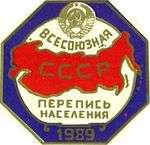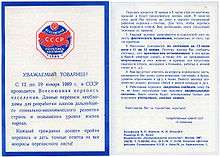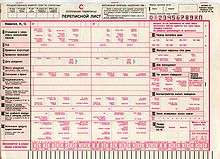Soviet Census (1989)
The 1989 Soviet census (Russian: Всесоюзная перепись населения 1989, "1989 All-Union Census"), conducted between 12-19 January of that year, was the last one that took place in the USSR. The census found the total population to be 286,730,819 inhabitants.[1] In 1989, the Soviet Union ranked as the third most populous in the world, above the United States (with 248,709,873 inhabitants according to the 1 April 1990 census), although it was well behind China and India.
| 1989 Soviet National Census | |
|---|---|
 Soviet State Emblem | |
 Census Logo | |
| General information | |
| Country | Soviet Union |
| Date taken | January 12, 1989– January 19, 1989 |
| Total population | 286,730,819 |
| Percent change | |
| Most populous republic | Russia 147,400,537 |
| Least populous republic | Estonia 1,572,916 |


Statistics
In 1989, about half of the Soviet Union's total population lived in Russia, and approximately one-sixth (18%) of them in Ukraine. Almost two-thirds (65.7%) of the population was urban, leaving the rural population with 34.3%.[2] In this way, its gradual increase continued, as shown by the series represented by 47.9%, 56.3% and 62.3% of 1959, 1970 and 1979 respectively.[3]
The last two national censuses (held in 1979 and 1989) showed that the country had been experiencing an average annual increase of about 2.5 million people, although it was a slight decrease from a figure of around 3 million per year in the previous intercensal period, 1959-1970. This post-war increase had contributed to the USSR's partial demographic recovery from the significant population loss that the USSR had suffered during the Great Patriotic War (the Eastern Front of World War II), and before it, during Stalin's Great Purge of 1936-1938. The previous postwar censuses, conducted in 1959, 1970 and 1979, had enumerated 208,826,650, 241,720,134, and 262,436,227 inhabitants respectively.[3]
In 1990, the Soviet Union was more populated than both the United States and Canada together, having some 40 million more inhabitants than the U.S. alone. However, after the dissolution of the Soviet Union in late 1991, the combined population of the 15 former Soviet republics stagnated at around 290 million inhabitants for the period 1995-2000.
This significant slowdown may in part be due to the remarkable socio-economic changes that followed the disintegration of the USSR, that have tended to reduce even more the already decreasing birth rates (which were already showing some signs of decline since the Soviet era, in particular among the people living in the European part of the Soviet Union). The next census was possibly planned for 1999.

SSR Rankings
1979 Census |
1989 Census[4] |
change | |||
|---|---|---|---|---|---|
| 1 | 137,551,000 | 147,400,537 | 9,849,537 |
7.2% | |
| 2 | 49,755,000 | 51,706,742 | 1,951,742 |
3.9% | |
| 3 | 15,391,000 | 19,905,158 | 4,514,158 |
29.3% | |
| 4 | 14,684,000 | 16,536,511 | 1,852,511 |
12.6% | |
| 5 | 9,560,000 | 10,199,709 | 639,709 |
6.7% | |
| 6 | 6,028,000 | 7,037,867 | 1,009,867 |
16.8% | |
| 7 | 5,015,000 | 5,443,359 | 428,359 |
8.5% | |
| 8 | 3,801,000 | 5,108,576 | 1,307,576 |
34.4% | |
| 9 | 3,947,000 | 4,337,592 | 390,592 |
9.9% | |
| 10 | 3,529,000 | 4,290,442 | 761,442 |
21.6% | |
| 11 | 3,398,000 | 3,689,779 | 291,779 |
8.6% | |
| 12 | 2,759,000 | 3,533,925 | 774,925 |
28.1% | |
| 13 | 3,031,000 | 3,287,677 | 256,677 |
8.5% | |
| 14 | 2,521,000 | 2,680,029 | 159,029 |
6.3% | |
| 15 | 1,466,000 | 1,572,916 | 106,916 |
7.3% | |
| 262,436,000 | 286,730,819 | 24,294,819 | 9.3% |
See also
- Demographics of the Soviet Union
- Republics of the Soviet Union
- Soviet Census (1937)
- First All-Union Census of the Soviet Union
- Soviet Union
References
- This is the total "de facto" population (nalichnoye naseleniye – наличное население); the "permanent" population (postoyannoye naseleniye – постоянное население) was about 1 million persons fewer. Over time, the State Statistics Committee changed its method of reporting population totals in censuses. In the 1959 and 1970 censuses, it used the permanent population; in 1979 and 1989 it used the de facto or present population. See Barbara A. Anderson and Brian D. Silver, "'Permanent' and 'Present' Populations in Soviet Statistics," Soviet Studies, Vol. 37, pp. 386-402, July 1985.
- Encyclopædia Britannica Book of the Year 1991, Soviet Union, page 720.
- United Nations: Demographic Yearbook, Historical supplement - Population by sex, residence, and intercensal rates of increase for total population, each census: 1948-1997, on the UN Statistics Division website (unstats.un.org Archived 2010-06-16 at the Wayback Machine).
- Almanaque Mundial 1996, Editorial América/Televisa, Mexico, 1995, pages 548-552 (Demografía/Biometría table).
Further reading
- Barbara A. Anderson and Brian D. Silver, "Growth and diversity of the population of the Soviet Union", The Annals of the American Academy of Political and Social Science , Vol. 510, No. 1, 155-177, 1990.
- Ralph S. Clem, Ed., Research Guide to Russian and Soviet Censuses, Ithaca: Cornell University Press, 1986.
- John C. Dewdney, "Population change in the Soviet Union, 1979-1989," Geography, Vol. 75, Pt. 3, No. 328, July 1990, 273-277.
External links
- Subjects of Russia, on the www.statoids.com website (it includes the demographic evolution of the Soviet Union's population).